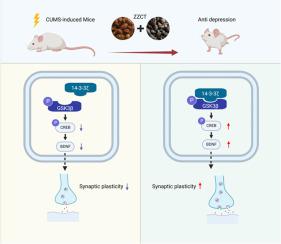Phytomedicine ( IF 7.9 ) Pub Date : 2023-05-18 , DOI: 10.1016/j.phymed.2023.154888 Weiwei Tao 1 , Guangda Yao 2 , Qiyu Yue 2 , Chunyan Xu 2 , Yue Hu 2 , XiaoLan Cheng 2 , Tong Zhao 2 , Mingming Qi 2 , Gang Chen 3 , Min Zhao 2 , Yue Yu 4

|
Background
Zhi-Zi-Chi-Tang (ZZCT) is an effective traditional Chinese medicinal formula. ZZCT has been used for the treatment of depression for centuries. Its clinical efficacy in relieving depression has been confirmed. However, the molecular mechanisms of ZZCT regarding neuroplasticity in the pathogenesis of depression have not yet been elucidated.
Purpose
The present study aimed to examine the effects of ZZCT on neuroplasticity in mice exposed to chronic unpredictable mild stress (CUMS), and to explore the underlying molecular mechanisms.
Methods
For this purpose, a murine model of depression was established using the CUMS procedure. Following the intragastric administration of ZZCT or fluoxetine, classic behavioral experiments were performed to observe the efficacy of ZZCT as an antidepressant. Immunofluorescence was used to label and quantify microtubule-associated protein (MAP2) and postsynaptic density protein (PSD95) in the hippocampus. Golgi staining was applied to visualize the dendritic spine density of neurons in the hippocampi. Isolated hippocampal slices were prepared to induce long-term potentiation (LTP) in the CA1 area. The hippocampal protein expression levels of glycogen synthase kinase-3β (GSK-3β), p-GSK-3β (Ser9), cAMP response element binding protein (CREB), p-CREB (Ser133), brain-derived neurotrophic factor (BDNF) and 14–3–3ζ were detected using western blot analysis. The interaction of 14–3–3ζ and p-GSK-3β (Ser9) was examined using co-immunoprecipitation. LV-shRNA was used to knockdown 14–3–3ζ by an intracerebroventricular injection.
Results
ZZCT (6 g/kg) and fluoxetine (20 mg/kg) alleviated depressive-like behavior, restored hippocampal MAP2+ PSD95+ intensity, and reversed the dendritic spine density of hippocampal neurons and LTP in the CA1 region of mice exposed to CUMS. Both low and high doses of ZZCT (3 and 6 g/kg) significantly promoted the binding of 14–3–3ζ to p-GSK-3β (Ser9) in the hippocampus, and ZZCT (6 g/kg) significantly promoted the phosphorylation of GSK-3β Ser9 and CREB Ser133 in the hippocampus. ZZCT (3 and 6 g/kg) upregulated hippocampal BDNF expression in mice exposed to CUMS. LV-sh14–3–3ξ reduced the antidepressant effects of ZZCT.
Conclusion
ZZCT exerted antidepressant effects against CUMS-stimulated depressive-like behavior mice. The knockdown of 14–3–3ζ using lentivirus confirmed that 14–3–3ζ was involved in the ZZCT-mediated antidepressant effects through GSK-3β/CREB/BDNF signaling. On the whole, these results suggest that the antidepressant effects of ZZCT are attributed to restoring damage by neuroplasticity enhancement via the 14–3–3ζ/GSK-3β/CREB/BDNF signaling pathway.
中文翻译:

14-3-3ζ 在神经可塑性调节中起着关键作用,而神经可塑性是栀子赤汤抗抑郁样作用的基础
背景
Zhi-Zi-Chi-Tang (ZZCT) 是一种有效的中药配方。ZZCT 几个世纪以来一直用于治疗抑郁症。其缓解抑郁症的临床疗效已得到证实。然而,ZZCT 在抑郁症发病机制中关于神经可塑性的分子机制尚未阐明。
目的
本研究旨在检测 ZZCT 对暴露于慢性不可预知轻度应激 (CUMS) 小鼠神经可塑性的影响,并探讨其潜在的分子机制。
方法
为此,使用 CUMS 程序建立了小鼠抑郁症模型。ZZCT或氟西汀灌胃后,进行经典行为实验观察ZZCT作为抗抑郁药的疗效。免疫荧光用于标记和量化海马中的微管相关蛋白 (MAP2) 和突触后密度蛋白 (PSD95)。应用高尔基体染色来可视化海马中神经元的树突棘密度。准备分离的海马切片以在 CA1 区域诱导长期增强 (LTP)。糖原合酶激酶-3β(GSK-3β)、p-GSK-3β(Ser9)、cAMP反应元件结合蛋白(CREB)、p-CREB(Ser133)、脑源性神经营养因子(BDNF)的海马蛋白表达水平使用蛋白质印迹分析检测到 14–3–3ζ。使用共免疫沉淀法检查 14–3–3ζ 和 p-GSK-3β (Ser9) 的相互作用。LV-shRNA 用于通过脑室内注射来敲低 14-3-3ζ。
结果
ZZCT (6 g/kg) 和氟西汀 (20 mg/kg) 减轻抑郁样行为,恢复海马 MAP2 + PSD95 +强度,并逆转暴露于 CUMS 的小鼠海马神经元和 CA1 区 LTP 的树突棘密度。低剂量和高剂量的 ZZCT(3 和 6 g/kg)均显着促进海马中 14-3-3ζ 与 p-GSK-3β (Ser9) 的结合,ZZCT (6 g/kg) 显着促进磷酸化海马体中 GSK-3β Ser9 和 CREB Ser133 的表达。ZZCT(3 和 6 g/kg)上调暴露于 CUMS 的小鼠的海马 BDNF 表达。LV-sh14–3–3ξ 降低了 ZZCT 的抗抑郁作用。
结论
ZZCT 对 CUMS 刺激的抑郁样行为小鼠具有抗抑郁作用。使用慢病毒敲低 14-3-3ζ 证实 14-3-3ζ 通过 GSK-3β/CREB/BDNF 信号传导参与 ZZCT 介导的抗抑郁作用。总的来说,这些结果表明 ZZCT 的抗抑郁作用归因于通过 14-3-3ζ/GSK-3β/CREB/BDNF 信号通路增强神经可塑性来恢复损伤。



























 京公网安备 11010802027423号
京公网安备 11010802027423号